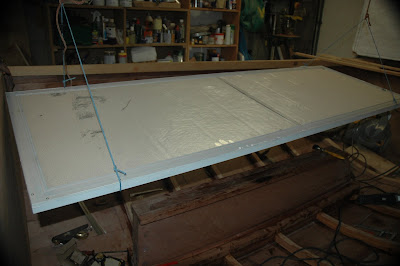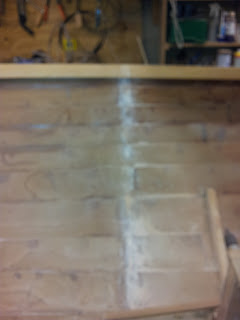First I needed to fit the trunk sole beam which slants downhill towards the stern. This necessitated removing some material from the underside of the aft end of the beam to ft against the trunk cleat. Confusing isn't it? I thought so, but now having built it, all seems crystal clear. That's one of many enjoyment factors I derive from this project - staring into a sea of mist and navigating to the destination...so to speak..
 I fitted out the sole beams which sit on top of the floors and are attached to the trunk by a "beveled mortice" joint - not one I had heard of before but I assume that this was what the designer specified.
I fitted out the sole beams which sit on top of the floors and are attached to the trunk by a "beveled mortice" joint - not one I had heard of before but I assume that this was what the designer specified.The beams are made from Douglas Fir and dimensioned to the same thickness of the floors. I enjoyed this process safe in the knowledge that any mistakes would be out of sight beneath the sole....as it transpired most of the joints were reasonably tight.
Getting the sole beams to fit to the floors was a little slower as I needed to pick up the curve and camber of the floors for each of the beams - 5 aside. I relied upon a torpedo spirit level to gauge where the beams should be attached to the floors and then did a final test by running a straight edge across the span of the beams ensuring that they were level with each other. So far so good.
 |
| Completed sole beams attached to trunk sole beam and floors |
I debated about whether to add the V notch into the bulkhead to create a paneling effect. So I bit the bullet and cut the notches using a V shaped cutter in a small router, which did a fine job. I'm glad I did as I think it looks quite good. Getting the bulkhead square and vertical to the waterline, required some more fine tuning, but I think it is a good fit now and ready for gluing to the hull.
Paneling effect looks quite authentic and adds relief to a large flat surface. Cut with a V shaped router. The grooves are in fact equidistant - the photo was taken from an angle which suggests otherwise.
The bulkhead itself seemed to be slightly warped so I had to clamp a straight board across the top of it to make sure everything was lined up correctly. The bulkhead is positioned vertical to the waterline so I relied upon a long spirit level to ensure it was.
Next I have to glue and fit the cleats to the for'ard of the bulkhead and refine the shape of the camber on top of the bulkhead.






















